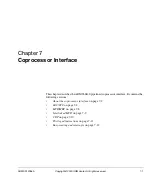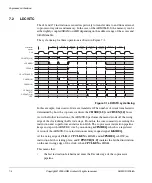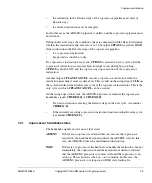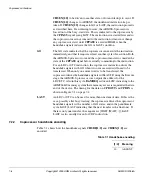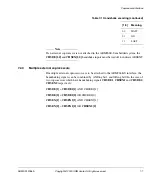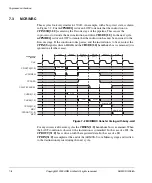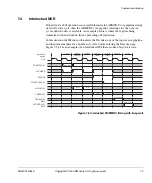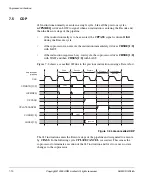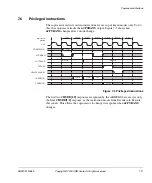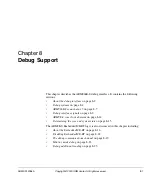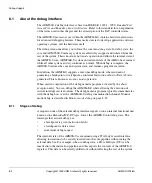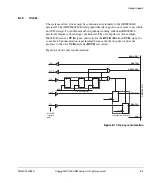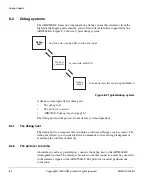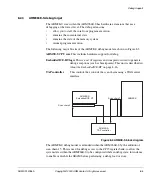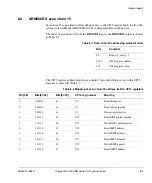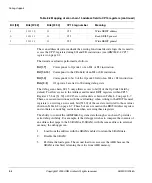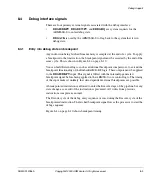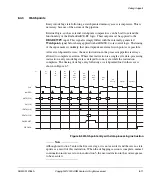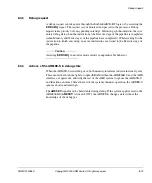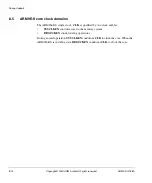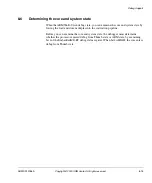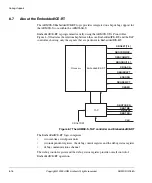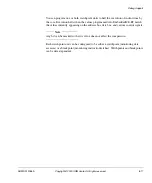
Debug Support
8-2
Copyright © 2000 ARM Limited. All rights reserved.
ARM DDI 0186A
8.1
About the debug interface
The
ARM966E-S
debug interface is based on IEEE Std. 1149.1- 1990,
Standard Test
Access Port and Boundary-Scan Architecture
. Refer to this standard for an explanation
of the terms used in this chapter and for a description of the TAP controller states.
The ARM9E-S processor core within the ARM966E-S contains hardware extensions
for advanced debugging features. These make it easier to develop application software,
operating systems, and the hardware itself.
The debug extensions allow you to force the core into
debug state
. In debug state, the
core and ARM966E-S memory system are effectively stopped, and isolated from the
rest of the system. This is known as
halt mode
operation and allows the internal state of
the ARM9E-S core, ARM966E-S system, and external state of the AHB to be examined
while all other system activity continues as normal. When debug is complete, the
ARM9E-S restores the core and system state, and resumes program execution.
In addition, the ARM9E-S supports a real-time debug mode, where instead of
generating a breakpoint or watchpoint, an internal Instruction Abort or Data Abort is
generated. This is known as
monitor mode
operation.
When used in conjunction with a debug monitor program activated by the abort
exception entry, You can debug the ARM966E-S while allowing the execution of
critical interrupt service routines. The debug monitor program typically communicates
with the debug host over the ARM966E-S debug communication channel. Monitor
mode debug is described in
8.1.1
Stages of debug
A request on one of the external debug interface signals, or on an internal functional unit
known as the
EmbeddedICE-RT logic
, forces the ARM9E-S into debug state. The
interrupts that activate debug are:
•
a breakpoint (a given instruction fetch)
•
a watchpoint (a data access)
•
an external debug request.
The internal state of the ARM9E-S is examined using a JTAG-style serial interface,
allowing instructions to be serially inserted into the core pipeline without using the
external data bus. For example, when in debug state, a
STore Multiple
(
STM
) can be
inserted into the instruction pipeline, and this exports the contents of the ARM9E-S
registers. This data can be serially shifted out without affecting the rest of the system.
Summary of Contents for ARM966E-S
Page 6: ...Contents vi Copyright 2000 ARM Limited All rights reserved ARM DDI 0186A ...
Page 20: ...Introduction 1 4 Copyright 2000 ARM Limited All rights reserved ARM DDI 0186A ...
Page 48: ...Tightly coupled SRAM 4 12 Copyright 2000 ARM Limited All rights reserved ARM DDI 0186A ...
Page 80: ...Bus Interface Unit 6 20 Copyright 2000 ARM Limited All rights reserved ARM DDI 0186A ...
Page 118: ...Debug Support 8 26 Copyright 2000 ARM Limited All rights reserved ARM DDI 0186A ...
Page 130: ...Test Support 10 8 Copyright 2000 ARM Limited All rights reserved ARM DDI 0186A ...
Page 142: ...Instruction cycle timings 11 12 Copyright 2000 ARM Limited All rights reserved ARM DDI 0186A ...
Page 158: ...Signal Descriptions A 16 Copyright 2000 ARM Limited All rights reserved ARM DDI 0186A ...
Page 176: ...AC Parameters B 18 Copyright 2000 ARM Limited All rights reserved ARM DDI 0186A ...


